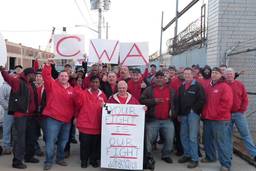In the wake of the historic pushback to Gov. Scott Walker’s antiunion agenda in Wisconsin, there has been a lot of talk about what is needed to revive the labor movement. Some claim that what is needed is a change in the overall political environment and labor’s public image to get people more enthusiastic about joining unions. Many felt that Wisconsin would change things for unions and make people more eager to join them.
The reality is that there is plenty of enthusiasm among workers to join unions; the problem is that the barriers to joining a union are so high that few workers are able to successfully join one. Only one out of six organizing campaigns results in a union contract. Public opinion polling consistently shows that a majority of workers would want to join a union if they could. In one out of three organizing campaigns, someone is fired for joining a union, and in half of all union campaigns the company threatens to move production to another facility if workers organize. Every year, 20,000 workers are fired, disciplined, or threatened with being fired for trying to join a union.
Thus many workers do not even try to join unions because they are afraid. So the question is: How does the labor movement convince people to take the risks associated with unionizing? In his book Reviving the Strike, Joe Burns argues that workers are willing to take the risk of joining unions if the economic benefits of joining a union outweigh the risks of what could happen.
But why would any worker see joining a union as something worth taking a massive risk on, when so many unions are more than willing to give massive concessions to the boss?
Writing in the Wall Street Journal, AFL-CIO President Richard Trumka endorsed the idea of going along with concessions by saying “We believe in shared sacrifice.” No major movement has emerged to stop concessions from employers making record profits. Many unions have been willing to make some concessions in exchange for keeping their right to represent union members.
“It seems many union leaders are willing to give whatever to the boss as long as they keep the part of the contract that says ‘dues deduction,’” says Don Trementozzi, President of CWA Local 1400. “Why would anyone want to join a union that won’t stand up for you”?
Labor leaders say they often have no choice but to give concessions — there’s no way to hold the line. Legally and economically, many unions feel that they could not engage in strikes to fight back against employers’ demands for concessions. In the 1950s, there was an average of 350 strikes a year involving 1,000 or more employees, in the 2000s there was an average of only 20 strikes a year involving 1,000 or more employees.
Burns (a Working In These Times contributor) argues in his book that the key to regaining union power is reviving the strike. The National Labor Relations Act, however, currently allows employers to permanently replace workers out on strike if the strike is ruled an “economic strike.” The only way to maintain an effective strike if workers can easily be replaced is to prevent scab replacement workers from crossing the picket line and to put economic pressure on a company to prevent the permanent hiring of scabs.
Making matters even more difficult, many unions are limited from forming effective picket lines by court injunctions and the Taft-Hartley Act forbids workers from engaging in secondary boycotts of companies that are financially profiting from the use of scab labor.
Burns argues that in order for unions to revive themselves, they must get tough and be willing to break labor laws and incur fines in order to win. Burns argues that unions should do what corporations do when they want to break the law — spin off subsidiaries with little assets when an individual union gets in trouble and needs to go on strike.
His ideas may sound controversial, but Burns notes that even conservative labor leaders like AFL President Samuel Gompers called on trade unionists to defy court injunctions against picketing. Even Richard Trumka broke labor laws that prohibited effective picket lines, wildcat strikes and secondary boycotts as the leader of the United Mineworkers during the Pittston Strike in the late 1980s, incurring $64 million worth of fines. (The Mineworkers wound up settling the fines out of court and did not have to pay them.)
A willingness to break restrictive laws about striking and boycotts is vital to drawing people back into the labor movement, Burns argues. A discussion of how to revive the strike is one that is surely needed among the country’s labor leaders — and on Wednesday, July 6 at 6:30 p.m., they’ll have a chance to discuss the idea with the author himself, when Burns gives a book talk at Busboys & Poets in Washington D.C.








